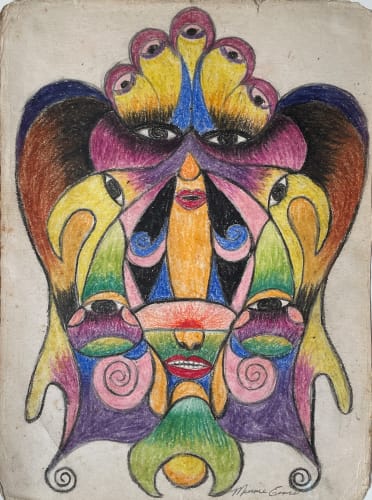Born in Long Creek, North Carolina, Minnie Evans embraced her creative sensibility late in life. On Good Friday—April 19, 1935—Evans had a vision in which a divine voice told her to “draw or die.” The result was two of her first drawings filled with “ancient writing,” repeating lines, and distinct visual registers. It was not until five years later, in 1940, that she rediscovered the drawings while cleaning her home. From that moment on, Evans conscientiously produced her signature chromatic, mythical drawings, sometimes executing as many as seven in one day as a form of religious discipline. The incessant instruction to draw guided her hand over the page and would recede as she worked—only to recur at night in her dreams. Deeply tied to her faith, Evans considered these messages gifts from God, and approached her art through the lens of Christian belief. Her drawings became exercises where she would revisit and contemplate her visual language over and over again, repeatedly addressing the same themes and motifs anew. Replete with hypnotic facial features, flora and fauna, Evans rarely diverged from these symmetrical abstractions; however, no two are identical.
Evans refused to provide interpretation of her work, readily acknowledging her own mystification at its process and portent: “They are just as strange to me as they are to anybody else.” This disjuncture between creator and object is unusual in the history of art and, as a result, has led scholars to seek out evidence of her source material. Indeed, Evans may have been subconsciously influenced by her surroundings in coastal North Carolina. From 1948 until her retirement in 1974, Evans worked as the gatekeeper of Airlie, a public garden in Wilmington, the historic port city situated between the Cape Fear River and Atlantic shoreline. Collecting admission tickets at the popular tourist attraction afforded Evans ample opportunity to observe the park’s seasonal splendor and shifts; the position also provided a steady flow of buyers for her drawings, priced at a mere fifty cents.
Additional possible references for Minnie Evans’s enigmatic drawings range from the Oriental rugs and decorative arts she regularly encountered in her employer’s house to Kongo cosmograms and Greco-Roman mythology. And Evans could be referencing all of these. Or none. As her work was created outside of the academic mainstream, it cannot readily be explained or interpreted through conventional means. The mainstream art market began to take full notice of Evans's achievements when, in 1975, fifty-six pieces of her work headlined an exhibition at the Whitney Museum of American Art.

